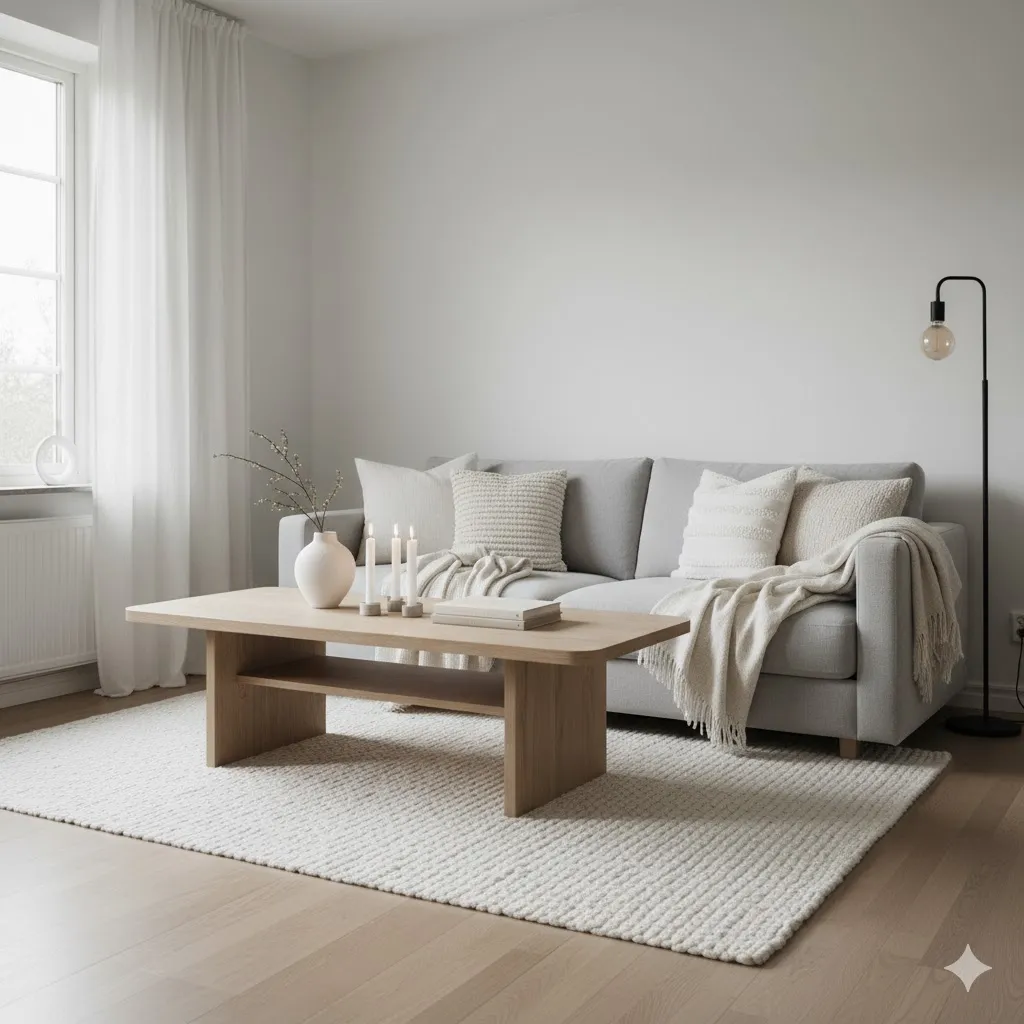Transform Your Home: 15 Cozy Living Room Designs for Ultimate Comfort
A cozy living room goes beyond trends—it’s a room that meets you where you are, any day of the week. It’s the spot where you slow down, connect, and breathe. The best part? You don’t need a full renovation to get there. With clear color choices, simple furniture shifts, and some tactile layers, you can turn a plain space into a warm retreat. Think soft light instead of glare, textures that invite touch, and layouts that help conversations flow. This guide walks you through 15 cozy living room designs plus practical tips for color, lighting, textiles, and layout, so your room feels like a hug from the moment you step in.
The Cozy Living Room Mindset: What “Comfort” Really Means in Daily Life
Comfort starts with how a space works for your routine. If you love movie nights, you need plush seating, dimmable lighting, and a throw within reach. If you read, you need a chair with back support and a lamp at the right height. A cozy living room doesn’t try to be perfect; it tries to be kind. That means soft edges, easy-care fabrics, and surfaces where a cup can land without stress. Cozy also means balance: fewer but better pieces, breathable textiles, and a color story that doesn’t fight your senses. When design choices support your habits, comfort becomes automatic.
Warmth You Can See, Touch, and Feel
Visual warmth shows up in color and light—think creamy whites, oat, caramel, and gentle greens. Tactile warmth comes from texture: boucle, chenille, linen, wool, and jute. Emotional warmth comes from personal items—photos you love, a handmade bowl, a travel book with notes tucked inside. Bring all three together and you get a room that welcomes you at any hour. Choose lamps with fabric shades for a soft glow, a chunky knit throw for instant calm, and a wooden tray to organize remotes and candles. When your eyes, hands, and heart feel cared for, the space reads truly cozy.
Comfort-First Styling vs. Photo-First Styling
Photo-first styling looks great in a snapshot, but real life needs function. Comfort-first styling plans for how you sit, snack, read, and chat. It means a side table within reach of every seat, a rug that feels good barefoot, and pillows that hold shape but don’t feel stiff. Storage baskets keep blankets handy. A lidded ottoman hides games and chargers. Yes, we still want pretty—stacked books, a vase with branches, framed art—but comfort wins the tie-breaker. When your setup supports everyday tasks without fuss, you’ll use the room more and feel better in it, day after day.
Check it : 15 Rustic Kitchen Designs – Warmth, Wood, and Whispers of Nature
Design 1 — Soft Neutrals and Layered Textures
A neutral base calms the eye, which is why this look is a cozy classic. Start with a warm white or light beige on walls, then layer texture: a linen sofa, a nubby rug, a knitted throw, and a couple of boucle or velvet pillows. Add pale woods—oak or ash—for coffee tables and frames. Keep metal accents warm (brass or bronze) instead of cold chrome. The secret is variety: mix smooth ceramics with woven baskets and one or two organic shapes like a curved lamp or pebble-shaped tray. The room stays light but never boring because texture carries the interest.

Design 2 — Modern Rustic with Wood, Stone, and Warm Metals
Modern rustic brings nature in without feeling heavy. Combine a simple sofa with a reclaimed-wood coffee table and a stone or travertine side table. Use leather in small doses—an ottoman or strap handles—for a warm, lived-in tone. Choose woven pendants or a linen drum shade for lighting, then finish with clay vases and dried stems. Keep the palette earthy—sand, tobacco, sage—and ground it with a deep rug. The result feels solid and timeless, perfect for anyone who wants warmth and character with modern lines. It’s cozy that wears well, season after season.

Design 3 — Calm Minimalism with Gentle Curves
Minimalism can be cozy when it’s soft, not stark. Pick a few large, comfortable pieces instead of many small ones: a curved sofa, a round coffee table, and an arched floor lamp. Use one main color and two supportive tones, then let texture do the talking—smooth plaster, slub linen, matte ceramics. Keep surfaces edited: a single bowl on the table, two framed prints on the wall, a small plant for life. The space breathes because there’s room around everything. Calm minimalism is great for smaller homes too, because it keeps sight lines clean and stress levels low.

Design 4 — Classic Farmhouse Comfort
Farmhouse cozy celebrates familiar materials and useful beauty. Think slipcovered sofas, woven baskets, wood beams (or faux beams), and a farmhouse-style coffee table. Add ticking-stripe cushions, a check throw, and a vase of fresh or dried flowers. Display everyday items—stacked plates, a pitcher—so the room feels welcoming and real. Soft white walls paired with warm wood tones make the space glow, while black accents (frames, cabinet pulls) add gentle contrast. The goal isn’t “country theme,” it’s easy hospitality. Every piece earns its keep, and nothing feels too precious to use.

Design 5 — Scandinavian Light and Hygge Layers
Scandi cozy is bright but grounded. Start with white or pale gray walls and bring in pale oak furniture, textured wool rugs, and simple, graceful forms. Layer cotton and linen in cushions and throws, keeping patterns subtle—fine stripes, tiny checks. Add a few plants and a paper lantern or two for soft diffusion. Candles matter here: group them on a tray for evening glow. Store clutter in lidded baskets so surfaces stay calm. Hygge is about togetherness and small joys, so leave space for board games, tea, and a good book within easy reach.

Design 6 — Moody Comfort with Deep Tones
Cozy doesn’t have to mean light colors. Deep olive, ink blue, or cocoa walls can feel like a soft cocoon—perfect for movie nights and long talks. To avoid a cave, add glow: table lamps with fabric shades, wall sconces on dimmers, and warm bulbs. Textures should be touchable—velvet cushions, wool throws, a thick rug underfoot. Metallic accents in antique brass or aged gold bring back sparkle. Keep artwork warm-toned or black-and-white so it doesn’t fight the walls. A moody room wraps you up, especially at night, and feels calm even when the day is loud.

Design 7 — Biophilic Bliss: Plants, Natural Fibers, and Daylight
Biophilic cozy borrows its cues from nature. Place plants in groups by light sources, mixing heights and leaf shapes for a “mini-forest” feel. Choose planters in clay, stone, or matte ceramic so the greenery stays the star. Use natural fibers—jute, sisal, rattan—for baskets and lighting. Keep window treatments light so daylight can flood in; sheer curtains soften glare without blocking the view. Add a small water element (a quiet tabletop fountain) if you like the sound. The room reads alive and fresh, and even the air feels better. It’s a daily reset without leaving home.

Design 8 — Small-Space Cozy: Studio and Apartment Solutions
In small rooms, warmth comes from smart choices. Use furniture with visible legs to keep the floor feeling open. Choose a round coffee table to improve flow, and add a storage ottoman for hidden blankets. Mirrors opposite windows bounce light. Wall-mounted shelves free up floor space and act like art when styled with books, a plant, and a small lamp. Stick to one main palette—two colors plus a warm neutral—so the room feels calm. A well-sized rug (front legs of furniture on the rug) pulls everything together and makes even tiny spaces feel intentional.

Design 9 — Family-Ready Cozy: Durable, Washable, Kid-Friendly
Real life is messy; cozy can handle it. Pick performance fabrics or slipcovers you can wash. Choose a sturdy coffee table with rounded corners and baskets underneath for toys or board games. Keep a throw that’s meant for forts and movie nights—no stress if it gets crumbs. Use washable rugs (there are many) in patterns that hide spills. Create a flexible layout: a floor cushion or pouf for extra seating, a storage bench for quick cleanup. When a room fits family life, you stop guarding it and start living in it—and that’s when cozy really lands.

Design 10 — Cozy on a Budget: High-Impact, Low-Cost Swaps
You don’t need a big spend to feel a big change. Focus on lighting (two lamps can transform evenings), textiles (new cushion covers and a throw), and one statement art piece—framed poster or your own photo printed large. Thrift for side tables and frames; paint them in a warm neutral. Swap shiny decor for matte or natural textures so the room looks higher-end. Shop your home: move a lamp from the bedroom, borrow a rug, or reframe existing art. Small, smart swaps create momentum—and a cozy look that feels thoughtful, not expensive.

Design 11 — Tech-Ready Cozy: Lighting Scenes, Sound, and Storage
Tech can boost comfort when it’s quiet and hidden. Use smart bulbs or a dimmer to set “reading,” “movie,” and “company” scenes. Tuck cords in cable sleeves and use furniture with built-in routing to keep things clean. A slim soundbar improves everyday TV sound without visual clutter. Hide remotes in a lidded box on the coffee table. If you game, choose a compact basket for controllers and headsets. Tech should serve the vibe, not run it. When light, sound, and storage are dialed in, the whole room feels calm and easy to use.

Design 12 — Global Cozy: Collected, Travel-Inspired Warmth
Global cozy is about story and soul. Mix textiles from different places—block-print cushions, a kilim rug, a Peruvian throw—with simple modern furniture. Let color guide you: pull two tones from your favorite textile and repeat them in art and accessories. Display travel finds in groups so they read as a curated moment, not scattered souvenirs. Use wood and clay to ground the look. The room should feel like a gentle conversation between objects you love. When each piece carries a memory, the space warms up instantly and becomes deeply yours.

Design 13 — Vintage & Thrifted Cozy: Soulful Pieces That Last
Vintage anchors a room with character. A mid-century chair, a carved side table, or a patinaed brass lamp adds depth that new pieces can’t fake. Refinish wood to a warm tone, rewire lamps for safety, and re-cover seats in durable fabric. Balance old with new—a clean-lined sofa beside a vintage cabinet keeps the look fresh. Thrift frames and add your photos or prints. Old books stacked under a plant make an easy vignette. Vintage is also practical: quality materials and solid build mean your cozy choices stand up to everyday use.

Design 14 — Rental-Friendly Cozy Upgrades
Rentals can be wonderfully cozy with reversible moves. Use peel-and-stick wallpaper or textured film on glass for privacy and warmth. Choose large area rugs to cover cold floors and define zones. Swap standard lamp shades for fabric ones to soften light. Replace cabinet knobs (save the originals) and hang art with removable hooks. Tall bookshelves create storage and a “built-in” feel without tools. A curtain rod mounted high widens windows and lets in more light. With a few smart swaps, you’ll feel settled without risking your deposit.

Design 15 — Seasonal Cozy: Quick Switches for Year-Round Comfort
Cozy should flex as seasons change. In cooler months, bring out the thicker throws, deeper colors, and candlelight. In spring and summer, switch to linen covers, lighter rugs, and a bowl of citrus or fresh greens on the table. Keep seasonal items in labeled bins so swapping is painless. A neutral base helps everything transition smoothly: sofas, big rugs, and larger furniture stay steady while pillows, art, and decor rotate. This rhythm keeps the room feeling alive—always fresh, always welcoming, never stuck in one season.

Layouts that Hug: Zoning, Flow, and Conversation Pockets
Layout is the quiet hero of cozy. Pull furniture off the walls and create a conversation zone around a rug. Make sure every seat has a landing spot—a side table or ottoman—for drinks and books. Leave clear walkways so moving through the room feels easy. If the room is long, split it into two areas: a main seating zone and a reading nook or desk corner. Use lighting to support zones: floor lamp by the chair, table lamp by the sofa, and a ceiling light on a dimmer for overall glow. When the layout supports your habits, comfort follows naturally.
The “U” Shape, The “L,” and The Paired-Chairs Moment
Three layouts work in most rooms. The “U” places sofa and two chairs around a coffee table—great for conversation. The “L” uses a sofa and one armchair or chaise, perfect for movie nights. The paired-chairs moment puts two comfy chairs by a window with a small table and lamp for reading or morning coffee. Choose based on how you live most. If you host often, the “U” wins. If you lounge and stream, the “L” is your friend. If you crave quiet time, the paired chairs deliver a pocket of peace that feels like a mini retreat.
Rug Sizing and Placement for Visual Warmth
A rug that’s too small makes a room feel disjointed. Aim for a size that lets at least the front legs of your seating sit on the rug—ideally all legs if the room allows. In a small space, a rug that fills most of the floor calms visual noise and adds instant warmth. Choose a texture that feels good: wool blends for softness, flatweave for easy cleaning, or washable rugs for families. Pattern can hide spills and add interest, but keep colors tied to your palette. The rug acts like a visual hearth, pulling the whole room into one cozy story.
Cozy Color Maps: Easy Palettes That Always Work
Start with a base (warm white, oat, or soft gray), add a main color (sage, clay, ink blue, or cocoa), and a supporting tone (butter, blush, or charcoal). Repeat these tones in textiles, art, and decor. This map keeps shopping focused and styling easy. If you like bolder color, use it as an accent—two cushions and a print—so the room still feels restful. Wood tone matters too: pale oak reads airy, walnut reads rich and traditional. Pick one wood family and repeat it across frames and small furniture so nothing feels random.
Lighting for Soft Glow: Lamps, Layering, and Dimmers
Overhead light alone can be harsh. Layer three types: ambient (ceiling or large floor lamp), task (reading lamps near seats), and accent (small lamps or candles for mood). Fabric shades diffuse light beautifully. Warm bulbs (around 2700K) keep skin tones flattering and rooms cozy. Place a lamp in the darkest corner to erase gloom. If you can, add dimmers—being able to dial light to the moment is a game changer. Light at different heights—floor, table, and sconce—creates softness and depth. Your room will feel cinematic in the best way, every evening.
Textiles that Invite: Cushions, Throws, and Rugs
Textiles are cozy’s secret sauce. Mix sizes and fills in cushions—some soft and squishy, others supportive—so everyone finds a favorite. Layer a throw over the sofa arm and another in a basket for easy reach. If your sofa is firm, add a plush rug to balance textures; if your sofa is soft, try a tighter-weave rug for contrast. Keep fabrics breathable: cotton, linen blends, wool. Use patterns carefully—checks, stripes, and small florals in your palette add charm without chaos. Washable covers make maintenance easy, so your cozy setup stays crisp and welcoming.
Final Touches: Scent, Sound, and Personal Stories
The last 10% makes the biggest difference. Scent sets mood: try herb, citrus, or soft wood notes, and keep labels simple to blend with decor. A slim speaker or turntable brings warmth through music—create a “morning slow” and “evening unwind” playlist. Add one personal story per surface: a framed photo, a handmade bowl, a small sculpture from a trip. Group decor in odd numbers and vary heights for balance. Leave breathing room so nothing feels crowded. When the room sounds good, smells gentle, and shows who you are, comfort becomes effortless and real.
Conclusion: Make Your Living Room a Daily Retreat
A cozy living room is built on simple ideas done well: a layout that supports your habits, light that flatters, textures that feel good, and colors that calm. From soft neutrals to moody cocoons, from rental tweaks to family-ready choices, these 15 designs give you a clear path to warmth without stress. Start with one zone, one palette, and a couple of lamps. Add a rug that ties your seating together. Layer throws and cushions. Then pause and enjoy. Comfort isn’t a finish line—it’s a daily gift you give yourself and everyone who walks through your door.
FAQs
1) What is the fastest way to make a living room feel cozy?
Swap in warm lamp light, add a textured throw and a couple of soft cushions, and group decor on a tray. These three moves change mood in minutes without big spending or heavy lifting.
2) How do I pick a cozy color palette that won’t date quickly?
Choose a warm neutral base, one nature-inspired color (sage, clay, ink blue), and a soft accent (butter, blush). Repeat them across textiles and art for a timeless look with gentle personality.
3) What size rug makes a room feel warm and pulled together?
Pick the largest size your room allows so at least the front legs of your seating sit on it. Bigger rugs make rooms feel calmer and more cohesive, especially in open-plan spaces.
4) Can a minimalist living room still be cozy?
Yes—use gentle curves, layered textiles, and warm bulbs. Keep surfaces edited but add tactile materials like linen, boucle, and wood so minimal looks soft, not stark.
5) How do I keep a cozy living room kid- and pet-friendly?
Use washable slipcovers and rugs, choose rounded-corner tables, and store throws and toys in lidded baskets. Performance fabrics and patterned rugs hide mess while keeping the look warm.







